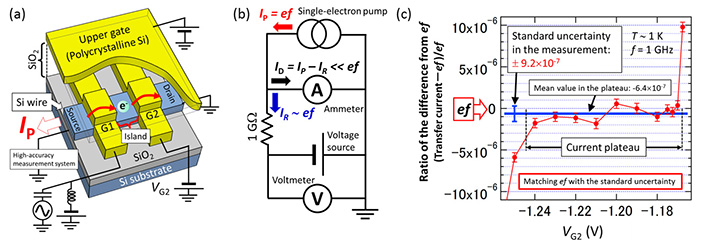World-record Accuracy of Gigahertz High-speed Single-electron Transfer
A single-electron (SE) pump can transfer electrons one by one with clock control. When the clock frequency is f, the pump generates accurate electric current ef, where e is the elementary charge. The accurate current can be used for the current standard, which corresponds to a ruler with which to measure electric current. Although there are many reports on SE transfer, it has been difficult to achieve high-accuracy operation at more than 1 GHz. Here, using a high-accuracy measurement system, we precisely measure a current generated by a Si SE pump [1] and demonstrate an ultralow transfer error rate of less than 9.2 × 10-7 at 1 GHz [2].
Figure 1(a) shows a schematic of the device, which has double-layer gate electrodes on a Si wire with a diameter on the order of 10 nm. By applying a DC voltage to the upper gate, we induce electrons in the Si wire. In addition, by applying a high-frequency clock signal and DC voltage (VG2) to lower gates G1 and G2, respectively, an electron from the source is captured by the island between G1 and G2, followed by its ejection to the drain. We measure the transfer current using a high-accuracy current measurement system [Fig. 1(b)], which has an ultralow measurement uncertainty of 8.8 × 10–7 achieved by the calibration using the Josephson voltage standard and quantum Hall resistance standard.
Figure 1(c) shows the ratio of the difference from ef at 1 GHz as a function of VG2. While the standard uncertainty of the measurements is 9.2 × 10–7, the mean of the measured values (normalized by ef) in the current plateau deviates only –6.4 × 10–7. This means that the measured current matches ef in the range of the standard uncertainty. In addition, the current plateau is flat with the level of 9.2 × 10–7. These results indicate that the transfer error rate is less than 9.2 × 10–7, which is a world-record accuracy in the gigahertz regime. Furthermore, we observe a transfer error rate of about 3 × 10–6 at 2 GHz. This indicates that our device breaks the 1-GHz barrier and is suitable for high-speed operation. In future work, we will optimize the measurement system and device structure to further improve accuracy, with the aim of realizing a high-accuracy current standard.
- [1] A. Fujiwara, K. Nishiguchi, and Y. Ono, Appl. Phys. Lett. 92, 042102 (2008).
- [2] G. Yamahata et al., Appl. Phys. Lett. 109, 013101 (2016).

|
| Fig. 1. (a) Schematic of the SE pump. (b) High-accuracy current measurement system, which has a 1-GΩ standard resistor and voltmeter calibrated by the primary standards. When IR ~ ef by setting the value of the voltage source, ID << ef. In this case, we can neglect the measurement uncertainty of ID. (c) High-accuracy measurement results at 1 GHz. |